Gas train for cylinders: device + DIY example
The operation of autonomous household equipment, the operating principle of which involves the use of natural gas, can be made more rational.For example, it is more convenient to operate gas boilers for a home heating system if there is a gas train for cylinders - a collector line where several vessels with gas are connected at once.
The design of the ramp provides the functions necessary for reliable operation of gas equipment. In this material we will tell you what a cylinder ramp is and how, if necessary, you can make it yourself.
The content of the article:
What is a gas cylinder ramp?
A direct connection from a gas cylinder to the same hot water boiler is often accompanied by disadvantages, which can be expressed, for example, in the form of pressure drops. Such conditions negatively affect the operation of the gas burner. As a result, unstable operation of the boiler, interruptions in the supply of hot water, etc. are noted.
It is for pressure stabilization that it is primarily recommended to use a ramp for gas cylinders, which you can do yourself.
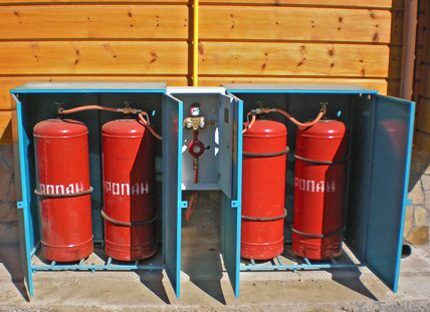
However, in general, the device gives the user a number of operational advantages:
- operational safety in case of possible leaks;
- providing equipment with stable operating pressure;
- ridding gas cylinders of the “freezing” effect;
- the ability to significantly reduce the frequency of calls to the gas filling service.
The technological diagram of a gas train may provide for the installation of a manifold for connecting both a small number of vessels and for the use of more than a dozen cylinders.

For domestic use, gas trains are most often made for two or four cylinders.
Design and assembly diagram of a gas train
The design of the manifold is a regular pipeline, equipped with a gas shut-off valve, equipped with additional elements:
- gas distribution fittings;
- pressure control devices;
- gas flow filter;
- discharge pipelines (high pressure hoses).
Gas supply distribution fittings are, as a rule, valves with an electromagnetic drive, but such are rarely installed in household circuits. Electrically driven valves perform switching of all individual lines that form a manifold group, connecting or disconnecting individual cylinders.
The group of pressure control and regulation devices consists of classical devices - pressure gauges and gas reducers. The filter is also used as a standard one - for gas systems.
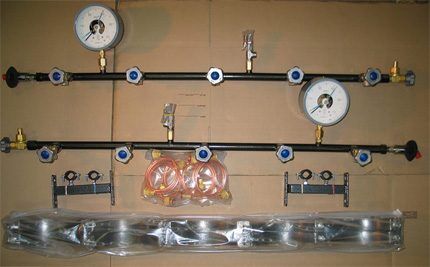
The assembly diagram of a simple classic ramp for gas cylinders is built as follows:
- A distribution manifold is created from a metal pipe.
- A filter is mounted at the collector inlet.
- After the filter, a reducer is installed.
- Further along the manifold, installation of fittings for outlets to the cylinders.
Industrial structures are usually supplemented with a leakage monitoring device. Its main purpose is tracking and closing/opening solenoid valves.
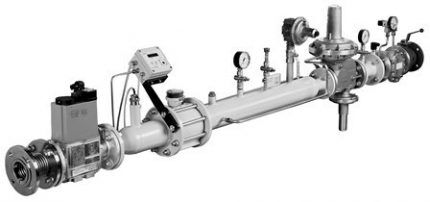
Meanwhile, ramps supplying gas to equipment with a power of less than 1 kW can be built without a leakage control module. It is this type of equipment that is used in most cases in the household sector.
Main installation requirements
Ramps are allowed to be installed inside separate (single-story) premises. It is also allowed and recommended to install gas trains for 2 cylinders, 4 cylinders or more, using metal cabinets for this.
If a system is being installed that involves technologically connecting no more than 40 cylinders, such ramps can be placed inside extensions to production or utility premises.
The bypass ramp, designed for connecting and installing no more than 6 gas cylinders, can be installed directly inside utility and industrial premises on the first floor. In this case, the volume of gas per container should not exceed 100 m33. For the household sector, the conditions are somewhat different.
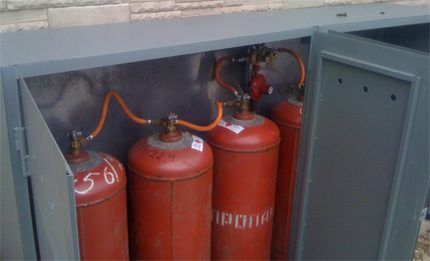
It should be remembered that gas ramps for 2 cylinders or more are allowed to be placed outside the boundaries of domestic premises, in places reliably protected from sources of open flame, heat, including solar radiation.
The installation location should be selected remote from basements and technical communications. The gas train structure must be protected from possible break-ins, mechanical impacts, etc.
Making a ramp with your own hands
It is not difficult to make a structure for storing and operating gas cylinders.
To assemble it yourself you will need:
- Steel sheet 2-3 mm thick.
- Steel angle No. 45 or profile pipe 40 x 25 mm.
- Metal pipe for the manifold (length is selected according to the number of cylinders).
- Small metal chain for fixing cylinders.
In addition to this material support, you will need the skills of a welder, mechanic, tools and equipment (welding machine). However, welding work can be performed to order.

Initially, you need to decide on the number of gas cylinders that will be installed in the ramp. For example, 3 cylinders. Based on the size of the diameter of the cylinders, the initial size of the width of the ramp structure is obtained and increased by 150-200 mm. The height size will be determined taking into account the height of the gas cylinders, plus 150-200 mm to the collector installation horizon.
Based on these calculations, a support frame is made from a steel angle or profile pipe. The support frame can be assembled by welding or a mechanical method of fastening the corners (pipes) with a bolted connection can be used. The assembled frame has the shape of the letter “P”.
Next, brackets for the manifold are placed on the upper crosspiece of the frame and the frame is secured to the rear wall inside a metal box pre-made from steel sheets.
Installation of the gas train manifold
Now it’s a matter of manufacturing the collector, installing it and adding all the necessary accessories. A metal pipe (d=32-50 mm) is measured along a length equal to the length of the support frame jumper and points for fittings (3 pieces) are marked on the pipe body.
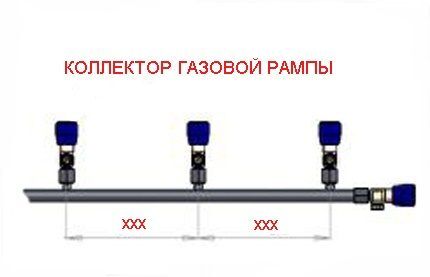
Carefully weld the fittings into the body of the pipe and install these parts along with the valves. A plug is placed at one end of the pipe, and at the other there is a fitting for connecting the gearbox. After completing this work, the collector is laid on the brackets previously mounted on the upper side of the support frame lintel.
The installation of the collector should be carried out taking into account the indentation above the level of the cylinder valves by 150-170 mm. The collector should be aligned as accurately as possible along the horizon and secured with clamps on the brackets, placing gaskets made of sheet technical rubber under the hoops of the clamps.
Then you need to install a gas reducer equipped with a filter on the open end of the manifold and add a shut-off valve.
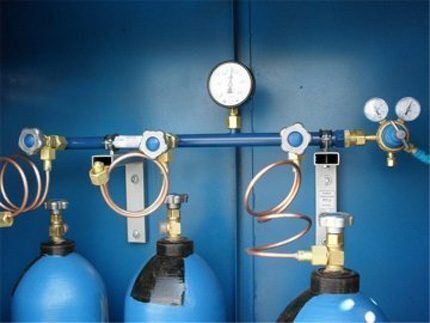
The next step is making liners for the cylinders. They can and preferably be made from a copper tube in order to obtain the expansion compensation effect. But it is also possible to use high pressure hoses.
The connections are screwed at one end to the manifold valves, and the other end of the tube will be connected to cylinder valves.
Final assembly and connection
To complete the process of assembling a ramp for gas cylinders with your own hands, a chain valve is made on the racks of the support frame, at a distance of 2/3 of the height of the cylinders.
To do this, perform the following actions:
- Take a metal chain.
- Measure along the length of the cylinder grip.
- Cut and attach the resulting section of chain with one end to the frame post.
The second end of the metal chain remains free. It will be secured with a locking device on the second post after the gas cylinders are loaded into the ramp. Of course, it is not at all necessary to use a metal chain as a retainer. You can use other suitable, but always reliable fasteners.

At the last stage of work, a gas pipe is connected from consumers to the manifold reducer. Technically, all that remains is to load gas cylinders onto the ramp, connect them with outlet pipes (hoses) to the manifold, and that’s all - the device is ready for a stable supply of gas to household equipment.
But there are still some installation details remaining.It is necessary to equip the doors of the steel cabinet where the ramp is installed. In the future, when the system is in use, it is necessary to equip the drawer doors with a reliable lock and limit access to it for children.
The procedure for putting the structure into operation
Before starting the system, it is recommended to purge the gas line from the consumer point to the point of its connection to the manifold reducer. After purging, the line is connected to the inlet fitting of the gearbox.
Next, perform the following steps sequentially:
- 3 propane cylinders are loaded onto the ramp.
- Secure the cylinders with a safety chain.
- Attach compensation tubes to the valves of the cylinders.
- Open the valves on the manifold and on the cylinders.
- Check the tightness of all connections.
- The required operating pressure value is set using the reducer regulator.
When the time comes to replace empty gas cylinders with filled vessels, simply close the valves on the vessels and on the manifold to quickly and safely make the replacement.
It is recommended to periodically check the system for leaks. This work should be done at least once a quarter. Actually, such a maintenance schedule is prescribed by the rules and requirements of those applied in the gas sector.
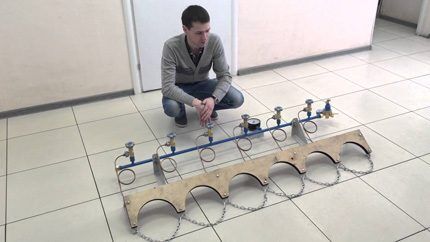
It should be remembered: structures such as gas ramps are allowed to be serviced only by persons who have passed the appropriate technical minimum. Devices of this type must be kept clean.
It is strictly forbidden to store technical oils and liquids, flammable components near the ramp. Naturally, smoking or working with fire on an operating ramp is unacceptable.
Conclusions and useful video on the topic
How gas cylinders are combined using a ramp:
Designs for loading, storage, and operation of several vessels at once are made not only for propane-butane, but also for acetylene, oxygen, carbon dioxide and others. True, natural gas still remains the main consumer product for the domestic sphere. Gas trains are most often made for this type of product.
Whatever purpose the design is intended for, it fundamentally changes the operating conditions of the equipment - making them more convenient for users and safer for others.
Do you have any questions about the topic of this article? Or maybe there is valuable information that you can share with our readers? Please leave comments, ask questions, and share your experience in the block below.




I read it with interest, I agree with everything, I will say more: during the Soviet Union, when there were big problems with gasification of private houses, my father did something similar. Of course, they were simpler and more primitive in design, but these devices really worked. But now, for example, our cylinders are filled with gas, which is frankly disgusting in quality, with many impurities. Is it worth the bother with manufacturing? Will it pull? And another question. Our winters are quite cold; if this unit is placed outside, at what minimum temperature can problems begin?
The minimum temperature at which the unit will operate depends on what mixture is pumped into the cylinders - winter or summer. There is more propane in the winter mixture and it will work up to 30 degrees if the cylinder is in a closed box. With a summer mixture that contains more butane, problems will arise much earlier.
Good afternoon. I would like to know, but I couldn't find the answer anywhere.
Please tell me, two cylinders are connected, working in pairs simultaneously through a tee to the heating boiler. Question: can gas be transferred from one cylinder to another, or is there a check valve on the reducer? For example, if you connect one empty and one full cylinder, will the gas in both cylinders be equal? Or not?
depends on where the gearbox is installed.
If each cylinder has its own reducer, then gas overflow between cylinders cannot happen in any way, since after the reducer the gas is already in a gaseous state.
And if the reducer is after the tee, then it is possible to equalize the level of liquefied gas in the cylinders. But, most likely, this will not happen if the cylinders are installed vertically and at the same level.
Hello, the minimum operating temperature for propane-based gas in winter is minus 44 degrees Celsius, for butane-based gas in summer is minus 0.5-3 degrees, depending on the concentration.